
| January 2002 | ||||||
| Sun | Mon | Tue | Wed | Thu | Fri | Sat |
| 1 | 2 | 3 | 4 | 5 | ||
| 6 | 7 | 8 | 9 | 10 | 11 | 12 |
| 13 | 14 | 15 | 16 | 17 | 18 | 19 |
| 20 | 21 | 22 | 23 | 24 | 25 | 26 |
| 27 | 28 | 29 | 30 | 31 | ||
Sunday 20 January 2002
At 1200, EST the Training Ship Empire State was located at 24 degrees and 30 minutes North Latitude and 081 degrees 09 minutes West Longitude, enroute to the Dry Tortugas, Florida. She was on a course of 187 degrees true traveling at a speed of 9.0 knots. The weather was EXCELLENT. Sunny, clear, light airs, air temperature was 86 degrees Fahrenheit, barometric pressure was 1021 millibars, humidity was 84 percent, seas were from the south-south east at 1 to 2 feet, sea injection temperature was 86 degrees Fahrenheit. Depth of water beneath the keel was 105 fathoms. Bahia Honda Key bears due north at 11 nautical miles
CAPTAIN'S LOG
"Mental toughness is many things and rather difficult to explain. Its qualities are sacrifice and self-denial. Also, most importantly, it is combined with a perfectly disciplined will that refuses to give in. It's a state of mind---you could call it character in action." - Vince Lombardi
First, I want to tell you that we enjoyed the game every bit as much as any die-hard Patriot fan in the country. We set up a bunch of TV sets throughout the ship to catch the action, but the most popular spot was in front of a 10 foot by 8 foot "big screen" that one of the techs set up in the cadet lounge. More than one hundred cadets cheered on the Pats from deep inside the ship. Did you hear us? None of us watching, however, could shake that strange feeling of looking at the snow storm on the TV screen... and then looking out the porthole at 75 degree weather and tropical breezes.
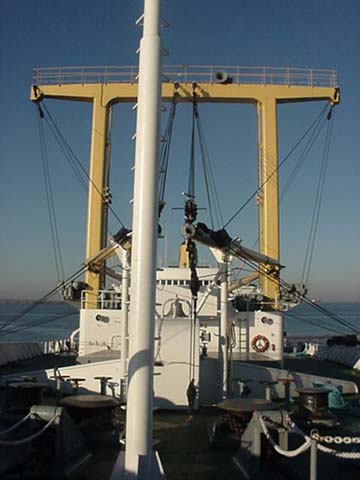
As soon as the game ended, we began to heave on the anchor. By 0024 this morning we were again underway.
Yesterday I wrote of the trials and tribulations that challenge those assigned to the Maintenance Division. Today I would like to briefly describe the duties of those in Watch Division. While the Training Division gets Sundays off and Maintenance only works a half day on Sunday or in port, the Watch Division never sleeps. Someone is always posted to stand sentinel over the machines that make our water and our electricity. Someone's eyes are always focused on the horizon or staring at the green glow of the radar screens. Even in port, the Watch tends the lines, guards against intruders and runs the critical equipment in the engine room. They are the fire party and are the ones who would respond to any emergency.
The Watch Division is more diverse than the Maintenance Division primarily because the Watch Division works in both the Engine Room and on the Bridge. Most cadets assigned to the Watch Division are majoring in either Marine Transportation or Marine Engineering. The Engineers are responsible for providing everything that we need to survive out here. They operate the high pressure boilers that generate steam for main propulsion and the turbine generators that produce electrical power. They operate the evaporators that make fresh water for the people aboard and for the boilers (whose taste is much fussier and more critical than humans). They warm us in the cold and cool us in the heat, and believe me, that is quite a chore.
Before entering the engineering spaces to assume the watch, the Cadet Engineer of the Watch does an accountability check and gathers his or her people to deliver the pre-watch safety seminar. Mandatory safety equipment such as flashlights, hearing protection, bump hats, and gloves is inspected. Standard watch standing procedures are reiterated and any emergent maintenance items are discussed. When satisfied that all is in order, the ongoing watch section enters the engine room, reports to the Staff Engineering Officer of the Watch, and requests permission to relieve the watch. Then the individual watch relief process begins. During the relief process, each watch stander obtains pertinent information regarding current plant conditions, expected changes to any equipment lineup, and any known or suspected abnormalities; particularly those associated with his or her particular duties. The process may seem unnecessarily cumbersome to those not familiar with running an engine room at sea but the reiterative procedures are essential. Each watch is important and one cannot permit vital functions to continue unmonitored. That becomes very evident when something breaks. There are no deep ocean repair facilities nearby and triple A does not provide roadside assistance in this neighborhood.
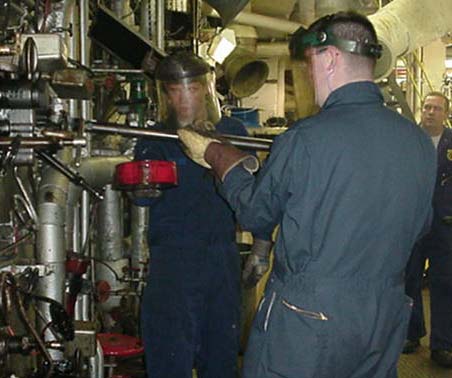
The Marine Transportation Majors "Deckies" as we affectionately call them, keep us safe from all harm (translation- minimize exposure to the air - water - dirt interface). The bridge of any modern, sea going vessel more resembles something from Star Wars than the wheelhouse so often depicted in Hollywood movies. The ship control spaces are crammed with advanced radar, navigation, and communication electronics. Deck cadets must work to achieve a level of mastery of all within their domain.
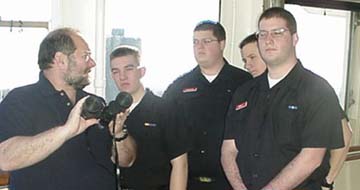
Watch Sections are organized almost identically to those in the engine room and for the same reasons. It is leadership lab as well as an important responsibility. The Cadet Officer of the Deck is accountable to the Master for the safe navigation and operation of the ship and for the safety of everyone aboard. The COOD has plenty of professional help available, but he or she is expected to operate the ship and make independent judgments regarding the best ways to proceed. And woe to those who make even a small mistake.
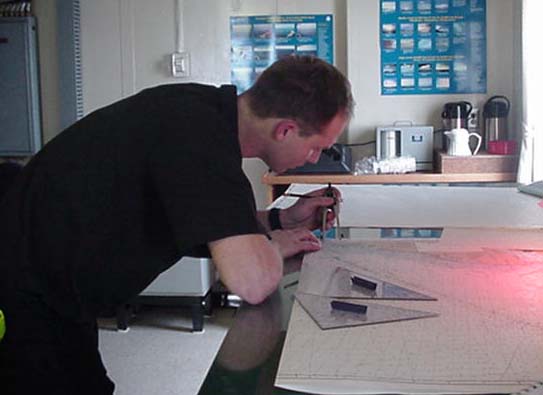
This may seem harsh to those familiar only with the ways of the beach but in five short months these young men and women may well be in control of a giant super tanker navigating the oceans of the world. Better to correct weakness here than to find it there.
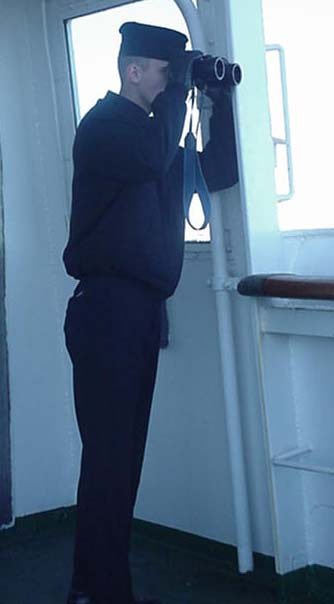
Each cadet starts at the bottom with limited responsibilities and learns/earns his or her way to the top. Freshmen typically stand watch as helmsmen and lookouts under the supervision of a more knowledgeable 3/C or 2/c cadet. The 1/C cadets (seniors) run the show. It is tough work and it is not for everybody.
Well, folks we are underway again and headed for the Dry Tortugas. We will anchor again on Monday to give another section of cadets the experience and then have the 3/c practice their lifeboat lowering/launching skills. No rest for the Watch Division. See You Tomorrow.